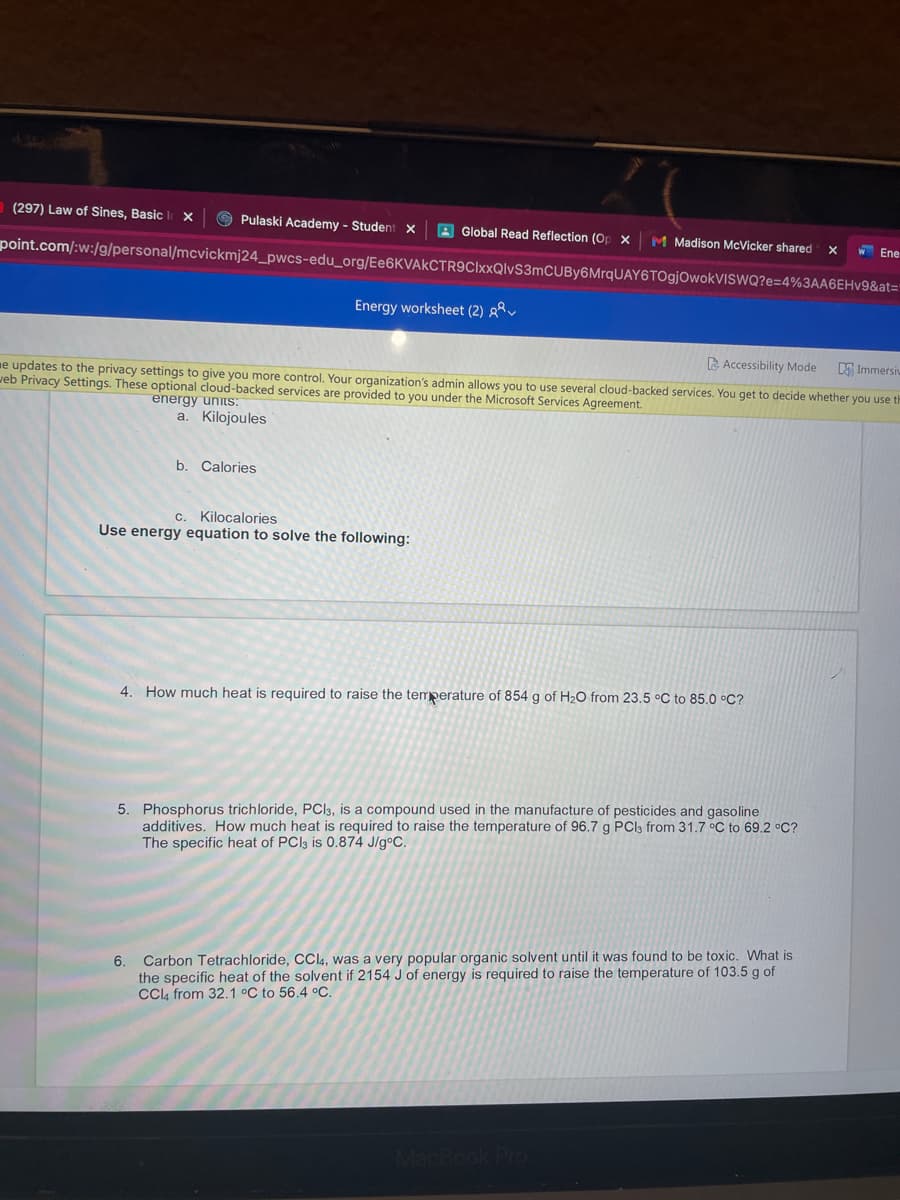Chemistry & Chemical Reactivity
10th Edition
ISBN:9781337399074
Author:John C. Kotz, Paul M. Treichel, John Townsend, David Treichel
Publisher:John C. Kotz, Paul M. Treichel, John Townsend, David Treichel
Chapter2: Atoms Molecules And Ions
Section: Chapter Questions
Problem 11PS: Marie Curie was born in Poland but studied and carried out her research in Paris. In 1903, she...
Related questions
Question
number 4

Transcribed Image Text:(297) Law of Sines, Basic
Pulaski Academy - Student X
A Global Read Reflection (Op x
M Madison McVicker shared x
W Ene
point.com/:w:/g/personal/mcvickmj24_pwcs-edu_org/Ee6KVAkCTR9CIxxQlvS3mCUBy6MrqUAY6TOgjOwokVISWQ?e=4%3AA6EHV9&at=
Energy worksheet (2) g
A Accessibility Mode
A Immersiv
ne updates to the privacy settings to give you more control. Your organization's admin allows you to use several cloud-backed services. You get to decide whether you use th
veb Privacy Settings. These optional cloud-backed services are provided to you under the Microsoft Services Agreement.
energy units:
a. Kilojoules
b. Calories
c. Kilocalories
Use energy equation to solve the following:
4. How much heat is required to raise the temperature of 854 g of H2O from 23.5 °C to 85.0 °C?
5. Phosphorus trichloride, PCI3, is a compound used in the manufacture of pesticides and gasoline
additives. How much heat is required to raise the temperature of 96.7 g PCl3 from 31.7 °C to 69.2 °C?
The specific heat of PCI3 is 0.874 J/g°C.
Carbon Tetrachloride, CCI4, was a very popular organic solvent until it was found to be toxic. What is
the specific heat of the solvent if 2154 J of energy is required to raise the temperature of 103.5 g of
Cl4 from 32.1 °C to 56.4 °C.
6.
Expert Solution
This question has been solved!
Explore an expertly crafted, step-by-step solution for a thorough understanding of key concepts.
This is a popular solution!
Trending now
This is a popular solution!
Step by step
Solved in 2 steps

Recommended textbooks for you

Chemistry & Chemical Reactivity
Chemistry
ISBN:
9781337399074
Author:
John C. Kotz, Paul M. Treichel, John Townsend, David Treichel
Publisher:
Cengage Learning

Chemistry & Chemical Reactivity
Chemistry
ISBN:
9781133949640
Author:
John C. Kotz, Paul M. Treichel, John Townsend, David Treichel
Publisher:
Cengage Learning


Chemistry & Chemical Reactivity
Chemistry
ISBN:
9781337399074
Author:
John C. Kotz, Paul M. Treichel, John Townsend, David Treichel
Publisher:
Cengage Learning

Chemistry & Chemical Reactivity
Chemistry
ISBN:
9781133949640
Author:
John C. Kotz, Paul M. Treichel, John Townsend, David Treichel
Publisher:
Cengage Learning



Organic Chemistry: A Guided Inquiry
Chemistry
ISBN:
9780618974122
Author:
Andrei Straumanis
Publisher:
Cengage Learning

Chemistry for Engineering Students
Chemistry
ISBN:
9781337398909
Author:
Lawrence S. Brown, Tom Holme
Publisher:
Cengage Learning